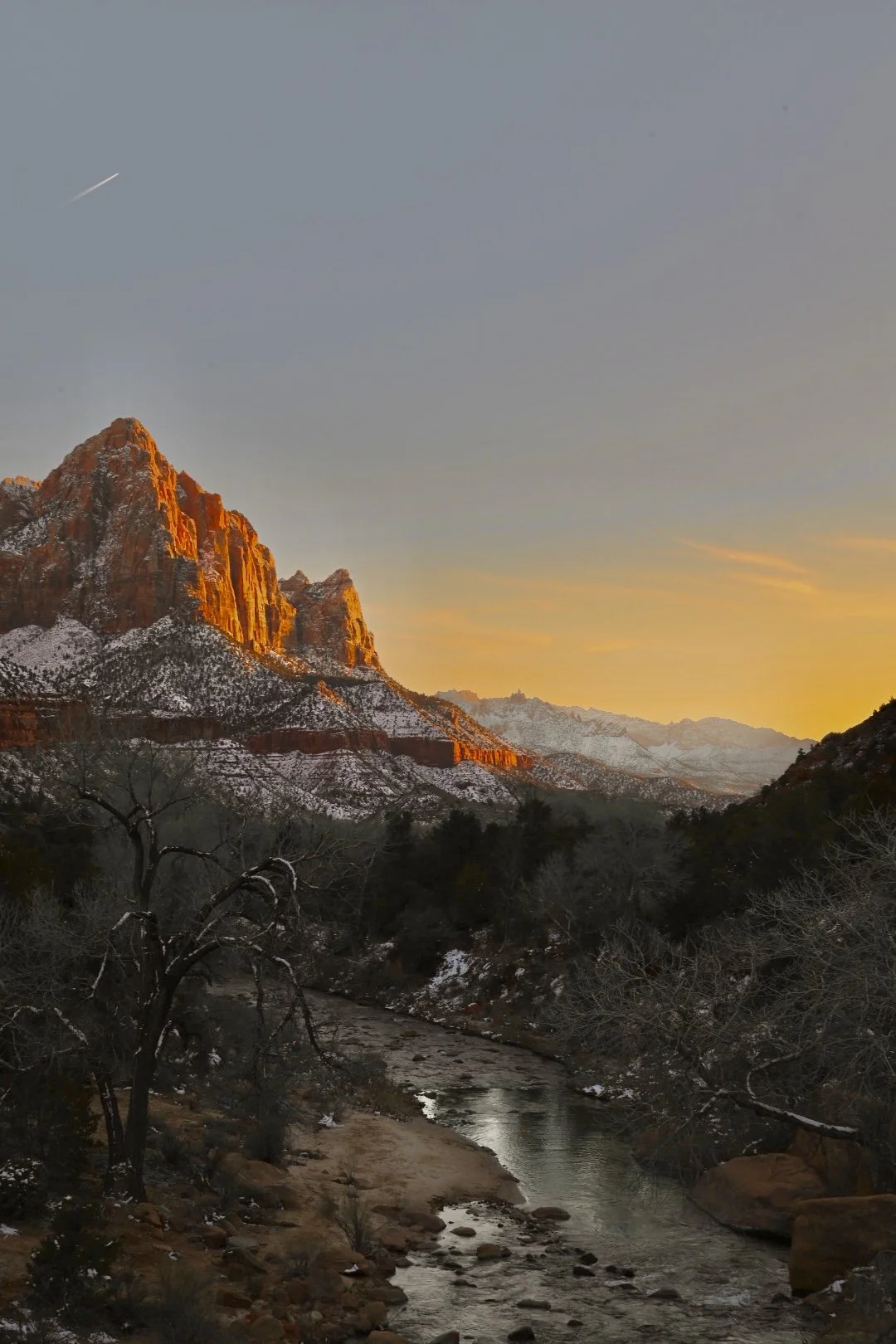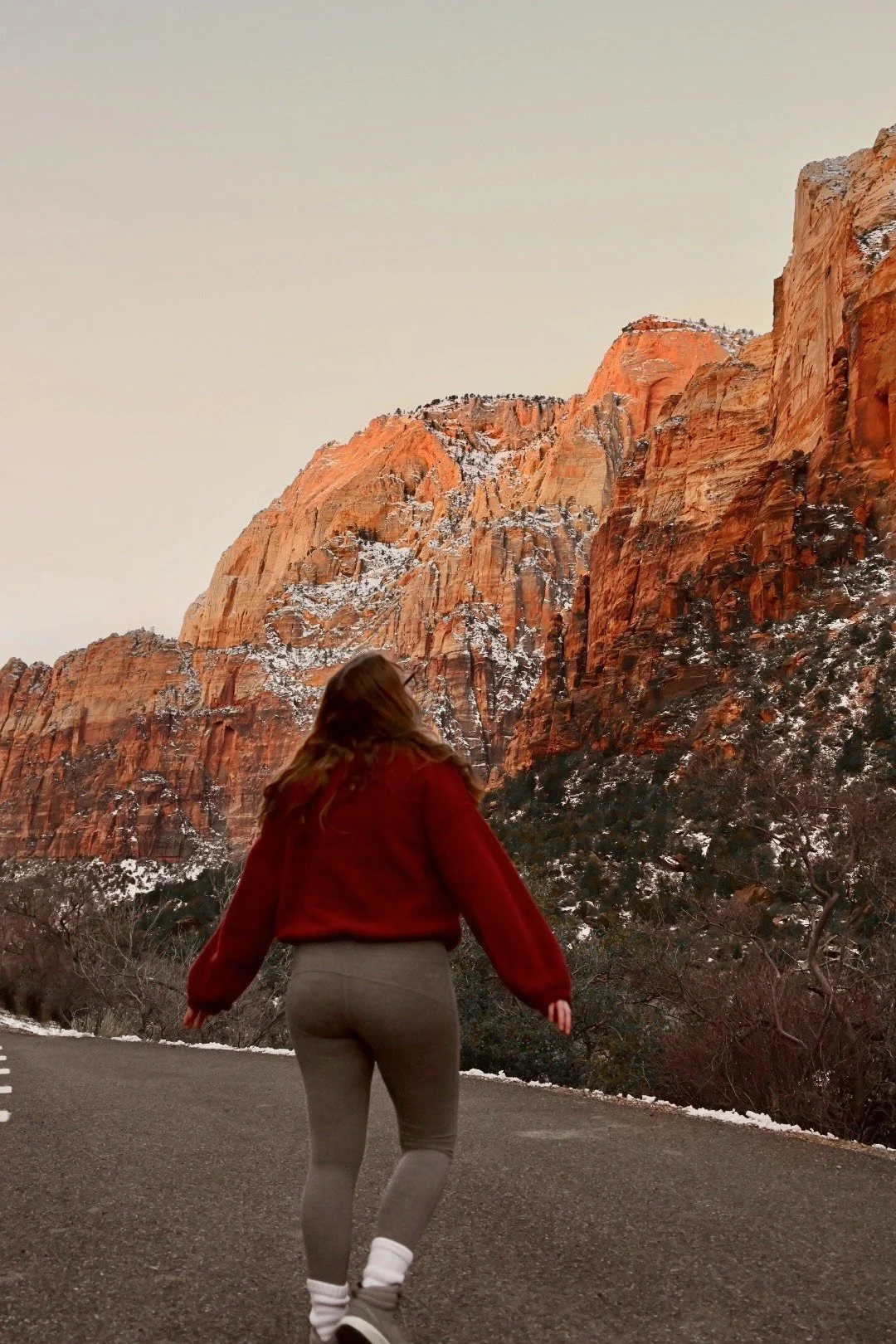
First-Timers Guide to Zion National Park
Zion National Park, Utah
Zion National Park is a vast and gorgeous place to spend time hiking, climbing, and camping. Here in Zion, you can find the famous Angels Landing trail and the Narrows Trail, but there are many other great trails to hike like Emerald Pools Trail, Canyon Overlook Trail, Watchman Trail, and East Rim Trail. Whether you are traveling here in the dead of winter or warm summer months, you can plan to have a great time in this national park in Utah.
If you are a first-time visitor to Zion National Park, you are in for a treat! Zion is a stunning national park located in southwestern Utah, known for its towering red cliffs, narrow slot canyons, and breathtaking hiking trails. Here is a guide to help you make the most of your visit:
Plan your visit
Check the official Zion National Park website for the latest information on park hours, closures, and any necessary permits or reservations. The park can get crowded, especially during peak seasons, so it is advisable to plan your visit ahead of time.
Lodging
Springdale, Utah is the last town before you enter Zion National Park. It is a quaint and charming town with plenty of restaurants, shops, grocery stores, and hotels. I was in Zion in February, and even during the winter months, there are still plenty open in the off-season. I recommend staying in Springdale to be closest to the park’s entrance. If you are in Zion during shuttle season, staying in Springdale will be a great way to catch a shuttle to take you in and out of the park and not have to drive in and find parking, which can be very limited during peak season. I stayed at the Holiday Inn Express Springdale - Zion Natl Park Area and thought it was a great hotel to stay at and would recommend it as a good hotel option for your time in Zion National Park
Zion National Park Lodge is the only hotel located within Zion National Park.
Rockville, Utah is the town over from Springdale and also has great hotel and camping options. The Zion National Park entrance is located about 5 miles northeast of Rockville. It’s a great option to save a little money on lodging since you are a bit further from the park entrance but just know there are really no places to eat nearby.
There are also some great campsites near Zion National Park, but be sure to plan ahead of time if you plan to camp, especially during the peak season.
Best campsites right near Zion National Park are Watchman Campground, South Campground, and Lava Point Campground.
Weather Throughout the Year in Zion National Park
The weather at Zion National Park varies throughout the year, with distinct seasons and different conditions for outdoor activities. Here's a general overview of the weather at Zion National Park by season:
Spring (March to May): Spring brings mild temperatures and is considered an ideal time to visit Zion. Daytime temperatures range from the 60s to 80s Fahrenheit (15-27 degrees Celsius), although it can still be chilly in March. Spring is also when wildflowers bloom, adding color to the landscape. However, keep in mind that spring can also bring occasional rain showers.
Summer (June to August): Summers at Zion National Park are hot, with temperatures often exceeding 90 degrees Fahrenheit (32 degrees Celsius) and occasionally reaching over 100 degrees Fahrenheit (38 degrees Celsius). July and August are the hottest months. It's important to stay hydrated, wear sunscreen, and plan outdoor activities early in the morning or late in the afternoon to avoid the peak heat. Thunderstorms are common during summer afternoons.
Fall (September to November): Fall is another popular time to visit Zion, with pleasant temperatures and beautiful autumn foliage. Daytime temperatures range from the 70s to 80s Fahrenheit (20-27 degrees Celsius) in September, cooling down to the 50s and 60s Fahrenheit (10-20 degrees Celsius) by November. It's a great time for hiking and outdoor activities, although evenings can be cooler, especially in November.
Winter (December to February): Winter in Zion National Park is relatively mild compared to other parts of Utah, but it can still bring cold temperatures and occasional snowfall. Daytime temperatures range from the 40s to 50s Fahrenheit (4-15 degrees Celsius), with colder temperatures at higher elevations. Some trails may be icy or closed due to snow, but winter offers a quieter and more serene experience in the park. It is advisable to have the proper gear for certain trails like ice cleats for Angels Landing or a wet suit for The Narrows Trail because of the cold water.
It's always recommended to check the weather forecast and road conditions before your visit, as weather patterns can vary. Additionally, be prepared for sudden changes in weather and dress in layers to accommodate temperature fluctuations throughout the day.
Getting to Zion National Park
There are several ways to get to Zion National Park depending on your starting point and preferred mode of transportation. Here are the different options:
Car: Driving is the most common way to reach Zion National Park. The park is located in southwestern Utah and is accessible via major highways. If you're coming from the west, take Interstate 15 and exit at either Exit 16 (for the south entrance) or Exit 27 (for the east entrance). If you're coming from the east, take Highway 9 through the Zion-Mount Carmel Tunnel.
Shuttle: Zion National Park operates a shuttle system within the park to alleviate traffic congestion and parking issues. From approximately mid-March to late November, private vehicles are not allowed on the Zion Canyon Scenic Drive, and visitors must park in designated areas near the visitor center and take the shuttle to access various stops and trailheads.
Airport: The closest major airport to Zion National Park is McCarran International Airport (LAS) in Las Vegas, Nevada, located about 160 miles (257 kilometers) southwest of the park. From the airport, you can rent a car and drive to Zion National Park in approximately 2.5 to 3 hours. Alternatively, there are shuttle services available that offer transportation from Las Vegas to Zion.
Bus: Several bus companies offer services to Zion National Park from nearby cities. These services may include guided tours or transportation only. Check with tour operators or bus companies for schedules and availability.
Train: Although there are no direct train services to Zion National Park, you can take a train to nearby cities such as Las Vegas or St. George and then arrange for ground transportation to the park.
Bike: If you're an avid cyclist or prefer a more adventurous approach, you can bike to Zion National Park. There are cycling routes and bike paths in the surrounding areas, but keep in mind that cycling within the park is restricted to certain areas and roads.
When planning your trip to Zion National Park, consider factors such as distance, transportation availability, and the time you have available. It's a good idea to check for any road closures or construction updates before you go.
Permits, Passes, and Fees for Zion National Park
To help maintain and preserve the park's resources, Zion National Park requires certain permits, passes, and fees. Here's an overview of the permits and fees you may encounter:
Entrance Fee: Zion National Park charges an entrance fee for private vehicles and individuals entering the park. The fees are subject to change, so it's best to check the official Zion National Park website for the most up-to-date information regarding entrance fees (website here).
America the Beautiful Pass: Zion National Park accepts the America the Beautiful Interagency Annual Pass, which grants access to federal recreation sites across the United States for a full year. This pass can be purchased at the park's entrance or online.
Zion National Park Pass: If you plan to visit Zion frequently or stay for an extended period, you can consider purchasing the Zion National Park Annual Pass. This pass provides unlimited entry to the park for one year from the month of purchase.
Backcountry Permits: If you're planning to camp in the backcountry or undertake overnight hikes, you'll need to obtain a backcountry permit. These permits allow you to access designated camping areas and trails within the park. Due to high demand, it's recommended to apply for backcountry permits well in advance. Visit the park's website or contact the Zion National Park Visitor Center for more information on obtaining backcountry permits (found here).
Canyoneering Permits: Canyoneering in certain areas of Zion National Park requires a separate permit. Canyoneering permits are limited and may have specific regulations and requirements. To obtain a canyoneering permit, you may need to participate in a lottery system or apply for advanced reservations. Check the park's website for details on canyoneering permits and the application process.
It's important to note that the park's rules and regulations are subject to change, so it's recommended to check the official Zion National Park website or contact the park's Visitor Center directly for the most current information regarding permits, passes, and fees.
Zion National Park Map
You can find the Zion National Park map on the National Park Service website here.
Hiking trails
Zion National Park offers a wide range of hiking trails suitable for all levels of experience. One of the most popular hikes is the Angels Landing Trail, which rewards you with awe-inspiring views from the summit. The Narrows is another must-do hike, where you can wade through the Virgin River in a majestic slot canyon. Remember to check the weather conditions and take appropriate gear for water hikes.
Watchman Trail
Pa'rus Trail Zion National Park
Emerald Pools Trailhead
Pine Creek Canyon Overlook
East Rim Trailhead
Scout Lookout
Observation Point
Riverside Walk Trailhead
East Mesa Trailhead
Many Pools Trailhead
Kolob Canyons
Shuttle system
To alleviate congestion, the park operates a mandatory shuttle system from mid-March to late November. You'll need to park in the designated visitor center area and take the shuttle to access various trailheads and points of interest. Be sure to check the shuttle schedule and plan accordingly.
Scenic drives
Besides the Zion Canyon Scenic Drive, which can only be driven through by personal cars when the shuttles are not running - usually in the winter months, there are other scenic drives worth exploring in the park. The Zion-Mount Carmel Highway offers incredible views, and you can stop at points like Checkerboard Mesa and the Zion-Mount Carmel Tunnel. The Kolob Canyons section in the northwest corner of the park also offers scenic drives with fewer crowds.
Wildlife and nature
Keep an eye out for the diverse wildlife that calls Zion home, including mule deer, bighorn sheep, and a variety of bird species. Take the time to appreciate the unique geology, colorful rock formations, and tranquil beauty of the park's natural landscapes.
Safety and preparation
Stay hydrated, wear comfortable hiking shoes, and carry essential supplies such as sunscreen, a hat, and plenty of water. Be cautious of flash floods and follow all safety guidelines provided by the park.
Remember to respect the park's rules, stay on designated trails, and leave no trace of your visit to help preserve the natural beauty of Zion National Park. Enjoy your time exploring this remarkable destination!
What’s Nearby?
There are plenty of other great things to do near and around Zion National Park, including:
Coral Pink Sand Dunes State Park (1 hour by car)
Bryce Canyon National (2 hours by car)
Escalante National Monument (1.5 hours by car)
The Wave (2.15 hours by car)
Page, Arizona (2.5 hours by car)
Lake Powell
Horseshoe Bend
For more things to do in Southern Utah, check out my blog post: USA Road Trip: The Best of Southern Utah














